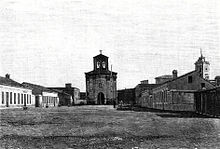Elizabeth II Island
The island of Isabel II is a Spanish island located in the Mediterranean Sea, off the north coast of Africa. Together with Isla del Congreso and Isla del Rey, it forms the archipelago of the Chafarinas Islands, a place of Spanish sovereignty. It has 15.3 hectares. Its name comes from the Spanish queen Isabel II. Spain took possession of it, like the rest of the Chafarinas, without protests or claims from France and Morocco.
The island is made up fundamentally of pyroxene andesites. In the area not occupied by the military base, whose surface is around half the island, 58 different botanical species have been found.
Population
It is the only inhabited island of the three. Although it once had a population close to a thousand people, currently there is only a military garrison on it, as well as personnel from the Spanish Ministry of the Environment, as the islands are a protected National Refuge due to the richness of its natural species.
During the summer months, a group of archaeologists also lives on the island, carrying out excavations at the Neolithic site discovered on Isla del Congreso, called El Zafrín, from the 5th millennium BC. C., headed by the Institute of Mediterranean Culture. The site is an open-air settlement from which several thousand cardial-type ceramic fragments have been obtained.
Buildings
The island has different military buildings. In addition, it has buildings such as the church of Nuestra Señora de la Concepción and the Torre de la Conquista, both from the mid-19th century, as well as a lighthouse, built at the beginning of the 20th century.
Church of Our Lady of Conception
In addition to the buildings and facilities of a military nature, the island has a church with a single nave of around two hundred and fifty square meters built between 1851 and 1853 under the dedication of the Virgen de la Concepción, which is currently in grave condition. abandoned state. It was the interim vicar of the parish church of Melilla, Bartolomé de Fuentes, who placed the three islands under the dedication of the Virgin on the same day of the occupation, on January 6, 1848. It has been rehabilitated on one occasion, in 1951.
Contenido relacionado
Campillo de Azaba
1471
Libertador San Martin
